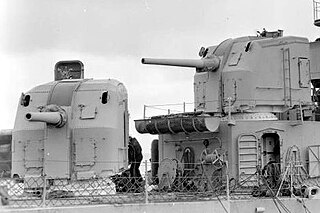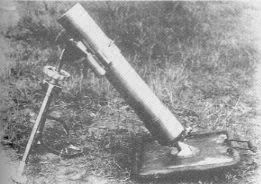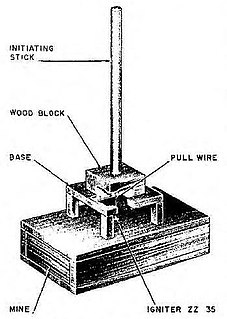
A naval mine is a self-contained explosive device placed in water to damage or destroy surface ships or submarines. Unlike depth charges, mines are deposited and left to wait until they are triggered by the approach of, or contact with, any vessel. Naval mines can be used offensively, to hamper enemy shipping movements or lock vessels into a harbour; or defensively, to protect friendly vessels and create "safe" zones. Mines allow the minelaying force commander to concentrate warships or defensive assets in mine-free areas giving the adversary three choices: undertake an expensive and time-consuming minesweeping effort, accept the casualties of challenging the minefield, or use the unmined waters where the greatest concentration of enemy firepower will be encountered.
A booby trap is a device or setup that is intended to kill, harm, or surprise a human being or an animal. It is triggered by the presence or actions of the victim and sometimes has some form of bait designed to lure the victim towards it. The trap may be set to act upon trespassers that enter restricted areas, and it can be triggered when the victim performs an action. It can also be triggered by vehicles driving along a road, as in the case of improvised explosive devices (IEDs).

A shell is a payload-carrying projectile that, as opposed to a solid round shot, contains an explosive, incendiary or other chemical fillings, though modern usage sometimes includes large solid kinetic projectiles properly termed shot. Solid shot may contain a pyrotechnic compound if a tracer or spotting charge is used. Originally it was called a bombshell, but "shell" has come to be unambiguous in a military context.

A firing pin or striker is part of the firing mechanism used in a firearm or explosive device, designed to ignite combustions/detonations by delivering an impact force to shock-sensitive compounds known as primers. Firing pins may take many forms, though the types used in fuzes for single-use devices generally have a sharpened point. In contrast, firing pins used in firearms usually have a small, rounded portion designed to strike the primer of a cartridge, detonating the priming compound, which then ignites the propellant (inside) or fires the detonator and booster.

An anti-tank mine is a type of land mine designed to damage or destroy vehicles including tanks and armored fighting vehicles.

The Mark 12 5"/38 caliber gun was a United States naval gun. The gun was installed into Single Purpose and dual purpose mounts used primarily by the US Navy. On these 5" mounts, single purpose (SP) means that the mount is limited to 35° elevation with no provision for AA shell fuze setters, and is designed to fire at surface targets only. Dual purpose (DP) means that it is designed to be effective against both surface and aircraft targets because it can elevate to 85° and has on mount AA shell fuze setters. The 38 caliber barrel was a mid-length compromise between the previous United States standard 5"/51 low-angle gun and 5"/25 anti-aircraft gun. United States naval gun terminology indicates the gun fired a projectile 5 inches (127 mm) in diameter, and the barrel was 38 calibers long, making the 5"/38 dual purpose midway in barrel length between the 5"/51 surface-to-surface and the 5"/25 anti-aircraft guns. The increased barrel length provided greatly improved performance in both anti-aircraft and anti-surface roles compared to the 5"/25 gun. However, except for the barrel length and the use of semi-fixed ammunition, the 5"/38 gun was derived from the 5"/25 gun. Both weapons had power ramming, which enabled rapid fire at high angles against aircraft. The 5"/38 entered service on USS Farragut, commissioned in 1934. The base ring mount, which improved the effective rate of fire, entered service on USS Gridley, commissioned in 1937.
The PP Mi-D mine is a Czechoslovakian copy of the German Second World War Schu-mine 42 anti-personnel mine.

The PMD-6, PMD-7 and PMD-57 series mines are Soviet Union blast-type anti-personnel mines that consist of a wooden box with a hinged lid with a slot cut into it. The slot presses down against a retaining pin, which holds back the striker. When sufficient pressure is applied to the lid of the box the retaining pin moves, allowing the striker to hit the detonator. The mines typically have an operating pressure of 1 to 10 kg. All the mines in the series use MOV series fuzes.

Anti-personnel mines are a form of mine designed for use against humans, as opposed to anti-tank mines, which are designed for use against vehicles. Anti-personnel mines may be classified into blast mines or fragmentation mines, the latter may or may not be a bounding mine.
The POMZ, POMZ-2 and POMZ-2M are three types of Soviet-made stake mounted anti-personnel fragmentation mine. The POMZ mine was used during the Second World War. It was superseded by the POMZ-2, and later by the improved POMZ-2M. These mines have been used in numerous conflicts, including the Vietnam War and the Korean War.

The Type 9 wooden anti-tank mine was an Italian bar type anti-tank mine used during World War II in North Africa. The box consisted of a lower section, containing the large warhead and fuzes and an upper, overlapping lid with two pivoting wooden covers that sat over the two fuzes. The fuzes were designed as a pivoting lever, and downward motion of the lid caused the lever to pull back a striker, compressing a striker spring until the pivoting action moved the lever enough to release the striker. The striker then impacted a blank cartridge, firing it, triggering a detonator charge, followed by the main charge.
In military munitions, a fuze is the part of the device that initiates function. In some applications, such as torpedoes, a fuze may be identified by function as the exploder. The relative complexity of even the earliest fuze designs can be seen in cutaway diagrams.
An artillery fuze or fuse is the type of munition fuze used with artillery munitions, typically projectiles fired by guns, howitzers and mortars. A fuze is a device that initiates an explosive function in a munition, most commonly causing it to detonate or release its contents, when its activation conditions are met. This action typically occurs a preset time after firing, or on physical contact with or detected proximity to the ground, a structure or other target. Fuze, a variant of fuse, is the official NATO spelling.

The Type 99 81 mm mortar was a Japanese mortar used primary by Imperial Japanese Army during World War II. The Type 99 designation was given to this gun as it was accepted in the year 2599 of the Japanese calendar (1939). The Type 99 81 mm mortar is typical of the Stokes-Brandt type mortar. The Type 99 81 mm mortar differs from the Type 97 81 mm infantry mortar in the shortness of its tube and in the method of firing. The differences between the Type 99 and the US 81-mm mortar, M1 are pronounced.

The B-Stabmine (Behelfs-Stabmine) or Makeshift Stickmine in English was an anti-tank mine that was developed by Germany and used by the Wehrmacht during World War II.
The A.T mine E.P mark V is a British anti-tank mine of World War II.Its is an improved version on the previous A.T mine E.P type mines such as the A.T. Mine E.P. Mk II.
The A.P. and Anti-Tire Mine was a British Anti-personnel mine and Anti-vehicle mine used in World War II.
The A.P.(anti-personnel) Mine E.P.(Eygptian pattern) No 4 was Anti-personnel mine in British use in World War II.
The A.P. Mine No.5 was a British Anti-personnel mine of World War II.
The Mine A.P. Improvised Type I was a British Anti-personnel mine of World War II.








